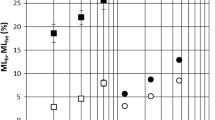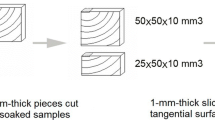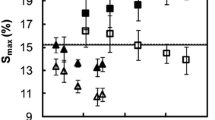Abstract
To clarify the effects of humidity during heating on the physical properties of hydrothermally treated wood, Sitka spruce wood was heated in an autoclave at 120 °C and different heating humidity (HRH), and their equilibrium moisture content (EMC), specific dynamic Young’s modulus (E′/ρ), and mechanical loss tangent (tanδ) were measured at 25 °C and 60 % RH prior to and after the hydrothermal treatment. Higher values of HRH resulted in greater loss in weight (WL) because of the acceleration of thermal degradation in the presence of moisture. The time–humidity superposition was applicable to the changes in WL. The EMC was minimized by heating at intermediate HRH (60 %), but it recovered significantly after the wood was moistened at 100 % RH. This fact suggested that the reduction in hygroscopicity due to hydrothermal treatment included both reversible and irreversible effects. The reversible effect was not observed when the wood was heated at 92 % HRH or above. After the moistening, the EMC value of hydrothermally treated wood decreased monotonically with increasing HRH and WL. An irreversible chemical change such as decomposition of hemicelluloses was responsible for the irreversible effect, whereas the reversible effect may have resulted from the annealing of amorphous wood polymers. After hydrothermal treatment at 80 % HRH or lower, E′/ρ increased and tanδ decreased mainly because of the reduction in EMC. On the other hand, high-humidity heating (92 % HRH) resulted in significant decrease in E′/ρ and remarkable increase in tanδ probably because of the depolymerization of hemicelluloses. The color of wood was darkened by the hydrothermal treatment, and the CIELAB color parameters of hydrothermally treated wood were closely connected to the WL.













Similar content being viewed by others
References
Abe K, Yamamoto H (2006) Change in mechanical interaction between cellulose microfibril and matrix substance in wood cell wall induced by hygrothermal treatment. J Wood Sci 52:107–110
Åkerholm M, Salmén L (2001) Interactions between wood polymers studied by dynamic FT-IR spectroscopy. Polymer 42:963–969
Bhuiyan MTR, Hirai N, Sobue N (2000) Changes of crystallinity in wood cellulose by heat treatment under dried and moist conditions. J Wood Sci 46:431–436
Borrega M, Kärenlampi P (2007) Hygroscopicity of heat-treated spruce wood. IN Proceedings of the Nordic workshop in wood engineering, Skellefteå, Sweden, February 21st
Borrega M, Kärenlampi P (2008) Mechanical behavior of heat-treated spruce (Picea abies) wood at constant moisture content and ambient humidity. Holz Roh Werkst 66:63–69
Brischke C, Welzbacher CR, Brandt K, Rapp AO (2007) Quality control of thermally modified timber: interrelationship between heat treatment intensities and CIE L*a*b* color data on homogenized wood samples. Holzforschung 61:19–22
Chédeville CG, Jääskeläinen AS, Froidevaux J, Hughes M, Navi P (2012) Natural and artificial ageing of spruce wood as observed by FTIR-ATR and UVRR spectroscopy. Holzforschung 66:163–170
Esteban LG, Gril J, Palacios PD, Casasús AG (2005) Reduction of wood hygroscopicity and associated dimensional response by repeated humidity cycles. Ann For Sci 62:275–284
Kato KL, Cameron RE (1999) Structure-property relationships in thermally aged cellulose fibers and paper. J Appl Polym Sci 74:1465–1477
Kojiro K, Furuta Y, Ishimaru Y (2008a) Influence of heating and drying history on micropores in dry wood. J Wood Sci 54:202–207
Kojiro K, Furuta Y, Ohkoshi M, Ishimaru Y, Yokoyama M, Sugiyama J, Kawai S, Mitsutani T, Ozaki H, Sakamoto M, Imamura M (2008b) Changes in micropores in dry wood with elapsed time in the environment. J Wood Sci 54:515–519
Kubojima Y, Okano T, Ohta M (1998) Vibrational properties of sitka spruce heat-treated in nitrogen gas. J Wood Sci 44:73–77
Kubojima Y, Okano T, Ohta M (2000) Bending strength and toughness of heat-treated wood. J Wood Sci 46:8–15
Matsuo M, Yokoyama M, Umemura K, Sugiyama J, Kawai S, Gril J, Kubodera S, Mitsutani T, Ozaki H, Sakamoto M, Imamura M (2011) Ageing of wood: analysis of color changes during natural ageing and heat treatment. Holzforschung 65:361–368
Millett MA, Gerhards CC (1972) Accelerated ageing: residual weight and flexural properties of wood heated in air at 115° to 175 °C. Wood Sci 4:193–201
Noguchi T, Obataya E, Ando K (2012) Effects of ageing on the vibrational properties of wood. J. Cult Heritage 13S:S21–S25
Obataya E (2010) Effects of ageing and heating on the mechanical properties of wood. In: Luca Uzielli (ed) Wood science for conservation of cultural heritage. Proceedings of the international conference on COST ACTION IE0601 in Florence, Firenze University Press, pp16–23
Obataya E, Norimoto M (1999) Acoustic properties of a reed (Arundo donax L.) used for the vibrating plate of a clarinet. J Acoust Soc Am 106:1106–1110
Obataya E, Tomita B (2002) Hygroscopicity of heat-treated wood II. Reversible and irreversible reductions in the hygroscopicity of wood due to heating (in Japanese). Mokuzai Gakkaishi 48:288–295
Obataya E, Ono T, Norimoto M (2000) Vibrational properties of wood along the grain. J Mater Sci 35:2993–3001, 6317
Obataya E, Higashihara T, Tomita B (2002) Hygroscopicity of heat-treated wood III, Effects of steaming on the hygroscopicity of wood (in Japanese). Mokuzai Gakkaishi 48:348–355
Obataya E, Shibutani S, Hanata K (2006) Doi S Effects of high temperature kiln drying on the practical performances of Japanese cedar wood II: changes in mechanical properties due to heating. J Wood Sci 52:111–114
Ono T (1996) Frequency responses of wood for musical instruments in relation to the vibrational properties. J Acoust Soc Jpn (E) 17:183–193
Sandberg D, Haller P, Navi P (2013) Thermo-hydro and thermo-hydro-mechanical wood processing: an opportunity for future environmentally friendly wood products. Wood Mat Sci Eng 8:64–88
Tjeerdsma BF, Militz H (2005) Chemical changes in hydrothermal treated wood: FTIR analysis of combined hydrothermal and dry heat-treated wood. Holz Roh-Werkst 63:102–111
Tjeerdsma BF, Boonstra M, Pizzi A, Takely P, Militz H (1998) Characterization of thermally modified wood: molecular reasons for wood performance improvement. Holz Roh- Werkst 56:149–153
Tolvaj L, Papp G, Varga D, Lang E (2012) Effect of steaming on the colour change of softwoods. BioResources 7:2799–2808
Wikberg H, Maunu SL (2004) Characterization of thermally modified hard- and softwoods by 13C CPMAS NMR. Carbohydr Polym 58:461–466
Yano H, Matsuhisa H (1991) Study on the timber of wood II, analysis of the sound spectrum of wood using viscoelastic Timoshenko equation. Sci Rep Kyoto Prefect Univ 43:24–31
Author information
Authors and Affiliations
Corresponding author
Rights and permissions
About this article
Cite this article
Endo, K., Obataya, E., Zeniya, N. et al. Effects of heating humidity on the physical properties of hydrothermally treated spruce wood. Wood Sci Technol 50, 1161–1179 (2016). https://doi.org/10.1007/s00226-016-0822-4
Received:
Published:
Issue Date:
DOI: https://doi.org/10.1007/s00226-016-0822-4




